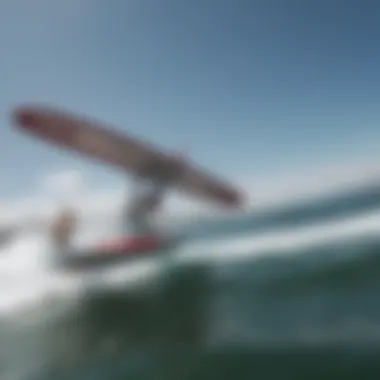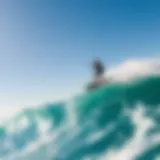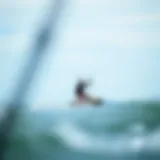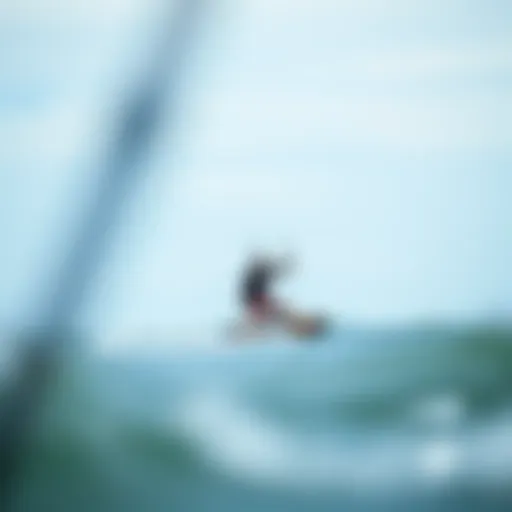Mastering Wing Surf Wings: A Comprehensive Guide


Intro
Wing surfing has undergone a remarkable transformation in recent years, captivating the hearts of many outdoor enthusiasts. This unique water sport combines elements of traditional surfing and kiteboarding but introduces its own distinct flair. Whether you are cruising across the water with the wind at your back or mastering new tricks on the waves, wing surfing demands a specialized understanding of gear and techniques to truly elevate your experience.
As we dig deeper, we’ll highlight essential aspects that every aspiring wing surfer should know, from the design and function of wing surf wings to safety considerations vital for any level of experience. We will also explore the gear required for optimal performance and unveil the trends shaping the future of this exhilarating sport. So, buckle up as we carve through the essentials of wing surfing.
Gear Insights
The wind is your friend in this sport, but without the right gear, you might find yourself battling the waves rather than enjoying them. Gear choice significantly affects your performance. As a wing surfer, investing in quality equipment can make or break your experience on the water.
Latest Gear Reviews
When it comes to wings, brands like Duotone, F-One, and Naish lead the charge with designs that push innovation boundaries. Duotone's new Wing Foil set is noted for its lightweight construction, allowing for responsive handling even in gusty conditions, while F-One's Strike series offers great stability, making it particularly suited to beginners. Naish's S26 Wing-Surfer is underlined for its versatility, catering to a broad spectrum of skill levels with manageable power.
But what do these high-quality products mean for the everyday user?
- Durability: Look for wings made from robust materials that resist wear and tear.
- Weight: Lightweight designs contribute to ease of handling.
- Size Options: A range of sizes can help you select the perfect fit for your weight and preferred conditions.
Essential Gear for Beginners
Starting out, you don’t have to break the bank. Here are a few essentials:
- Wing: The heart of the sport. Choose a size that matches your weight and the type of conditions you plan to ride in.
- Board: Look for a stable board that suits your experience; often, larger boards offer more stability.
- Harness: A comfortable harness distributes the wing’s pull, making for a smoother ride.
- Safety Equipment: Always equip yourself with a personal flotation device (PFD) and consider a helmet.
Investing in the right gear sets the stage for successful days on the water.
Techniques and Tips
Wing surfing isn’t just about gear; it’s about mastering the wind and knowing how to work with it. Improving your skills means incorporating various techniques that will ensure an enjoyable ride.
Advanced Tricks and Techniques
When you've grasped the basics, it’s time to ramp things up. Here are few advanced maneuvers to challenge yourself with:
- Jumping: Learn how to harness wind power. Timing and body positioning are crucial here.
- Tack and Jibe: Master these turns to navigate efficiently. They can drastically improve your maneuverability on the water.
- Wave Riding: For those ready to take the plunge, riding waves combines speed and skill, presenting a rewarding challenge.
Each of these techniques requires practice. Don’t rush; it’s important to build your confidence steadily.
Safety Practices for Kiteboarders
The thrill of wing surfing comes with its own risks, making safety paramount. Here are crucial practices:
- Know the Environment: Be aware of your surroundings. Understand wind patterns and watch for obstacles.
- Buddy System: Always surf with a friend whenever possible. In situations where things go awry, assistance is invaluable.
- Emergency Procedures: Familiarize yourself with self-rescue techniques and always carry a whistle or signaling tool.
"Safety doesn’t happen by accident. It’s a choice we make each time we step in the water."
Preparation and knowledge can protect you against potential hazards.
By focusing on gear insights and the foundational techniques necessary for wing surfing, aspiring enthusiasts can embark on their journey with confidence. No matter where you are on this path, continued learning and attention to safety will enhance your experience, ensuring that each outing on the water is both thrilling and secure.
Preamble to Wing Surf Wings
In recent years, the phenomenon of wing surfing has captured the attention of water sports enthusiasts worldwide. As an exciting blend of wind and water sports, wing surfing brings a sense of freedom and excitement that many seek. Understanding the nuances of wing surf wings is vital not just for the practitioners but also for those simply curious about the sport. The appeal lies in its accessibility and versatility, making it an intriguing choice for kiteboarders, instructors, travelers, adventurers, and hobbyists alike.
Defining Wing Surfing
Wing surfing involves harnessing the power of wind to propel oneself over water using a wing—a hand-held sail. Unlike traditional kiteboarding, where the harness is attached to a kite, in wing surfing, the rider holds the wing independently. As riders maneuver, their bodies shift in response to the wing's position, offering a unique experience of balance and control.
The core idea revolves around freedom—freedom to choose your location, freedom to explore different wind conditions, and freedom in your movements. This combination has made wing surfing appealing to both novices and seasoned water sports lovers.
Historical Context
The concept of using wings on water isn’t entirely new. It can be traced back to the early days of surfing and windsurfing. The first notable attempts at combining wind energy and water sports really took flight in the early 2000s, but it wasn't until recent innovations in wing design and materials that wing surfing began to gain notable traction.
Early prototypes were clunky and less efficient, often resulting in frustrating experiences for first-timers. However, advancements in technology, like lightweight materials and improved aerodynamic shapes, transformd the wings into sleek, effective tools that enhance performance.
Today, wing surfing represents a growing culture, bringing with it vibrant communities and events. Riders share tips and experiences online, fostering camaraderie among enthusiasts. It is fascinating to see how this sport evolves, influenced by both technology and participant creativity.
"Wing surfing is more than a sport; it’s an ever-evolving journey where innovation meets passion.”
As we delve deeper into this article, we will explore the intricate details surrounding wing surf wings—from their anatomy and performance metrics to tips for beginners who are just entering this exhilarating realm.


Anatomy of Wing Surf Wings
Examining the anatomy of wing surf wings is pivotal for any enthusiast, whether new to the sport or seasoned pro. Each component serves a distinct purpose, contributing to overall performance and versatility. Understanding materials, structural elements, and design variations can significantly enhance your riding experience, offering not just functionality but also a glimpse into the innovative spirit behind these devices. A solid grasp of these elements allows for informed choices, optimizing both safety and enjoyment on the water.
Materials Used
The materials that compose wing surf wings are crucial in determining their performance and durability. Commonly, wings are crafted from lightweight yet robust substances like ripstop nylon or polyester. These fabrics boast high tear strength and resistance to UV light, making them a solid choice for enduring various conditions. Additionally, some high-end wings utilize mylar or other composite materials that significantly reduce weight while enhancing stiffness and responsiveness.
- Ripstop Nylon: Known for its grid pattern, which prevents tears from spreading, making it a reliable choice.
- Polyester: Offers a good balance between strength and weight, often used in budget-friendly wings.
- Mylar: Lightweight and abrasion-resistant, favored in premium options for its excellent performance in gusty winds.
These materials play a significant role in the wing's overall functionality. The right fabric enhances the wing’s aerodynamics, making it easier to control while also optimizing lift when zipping across the waves.
Structural Components
A wing surf wing's structure comprises several key components that work together harmoniously for the best performance. Each part plays an important role in how the wing responds to wind and water conditions.
- Leading Edge: This is the front part of the wing, which cuts through the wind. A well-designed leading edge can greatly affect the lift and stability of the wing.
- Struts: These are the support beams that maintain the wing's shape. They further distribute the load evenly, channeling forces throughout the structure.
- Trailing Edge: The rear edge contributes to the wing's maneuverability. A tapered trailing edge can produce smoother airflows, allowing for better control and less drag.
The interaction of these components determines how responsive a wing will be. Riders should pay close attention to how these parts are constructed when selecting a wing, as they impact everything from top speed to the overall riding experience.
Design Variations
When it comes to design, wing surf wings showcase an array of styles and shapes, each tailored for specific riding preferences and conditions. Varied designs cater to different skill levels and intended uses, whether for trick riding, touring, or freestyle.
- Aspect Ratio: Wings come in high aspect ratios and low aspect ratios. High aspect ratio wings offer better efficiency and speed but may be harder to maneuver, while low aspect ratio wings provide stability and ease, making them suitable for beginners.
- Size: The size of the wing directly influences its performance. Smaller wings are generally more agile and faster, ideal for experienced riders, whereas larger wings provide more lift, allowing beginners to get off the ground more easily.
- Shape: Some wings feature a more rounded shape for better stability, while others possess sharper designs for added speed and agility.
Overall, understanding these design variations helps riders choose a wing that matches their ambitions and conditions, elevating their experience in the water.
"Selecting the right materials, components, and design can make a significant difference in how a rider connects with the sport. Small adjustments can lead to greater performance."
By considering the anatomy of wing surf wings, riders can make educated choices that align with their personal style and the typical conditions they face.
Understanding Performance Metrics
Understanding performance metrics plays a crucial role in mastering wing surfing. By recognizing how various elements influence your ride, you gain insights that can drastically enhance your overall experience. Performance metrics not only help you measure your success but also guide you in adjusting your technique and gear.
Lift and Drag Forces
Lift and drag forces are fundamental concepts in aerodynamics that specifically affect wing surf wings. Lift is what elevates the surfer above the water, derived from the difference in air pressure on the top and bottom surfaces of the wing. When you harness the right amount of wind and angle your wing properly, you can achieve significant lift, allowing for smoother rides and higher jumps.
On the flip side, drag continuously works against your forward motion. You can think of drag as the invisible hand slowing you down. Minimizing drag is essential for better speed and efficiency. Factors that contribute to drag include the shape of the wing, the surface area, and how effectively the wing is angled through the air.
To illustrate:
- Lift can be increased by:
- Drag can be reduced by:
- Choosing the right angle of attack
- Adjusting your speed
- Streamlining wing design
- Reducing surface friction
A delicate balance of these two forces can be a game changer in achieving optimal performance.
Aspect Ratio Influence
Aspect ratio refers to the ratio of the wingspan to the average wing width. In wing surfing, this measurement is vital because it significantly influences both the lift-to-drag ratio and overall performance. Higher aspect ratio wings usually provide better lift due to their elongated shape, cutting through the wind more efficiently. This means that with higher aspect ratio wings, you can achieve greater distances while consuming less energy.
However, higher aspect ratios can sometimes compromise stability, especially in choppy conditions. Conversely, wings with a lower aspect ratio tend to be more stable but might not offer the same level of performance over long distances. Thus, selecting a wing that aligns with your skill level, style, and the conditions you’ll be surfing in is of utmost importance.
Stability and Control
Stability and control are the cornerstones of a successful wing surfing experience. The degree of stability a wing provides directly affects how confidently you can maneuver through varying wind conditions and water surfaces. A stable wing allows the rider to perform without the constant worry of losing control, enabling them to focus on honing their skills.
Several factors contribute to stability and control:
- Wing shape:
Wider wings generally offer better stability, whereas narrower ones enhance speed. - Weight of the wing:
A heavier wing can feel more secure in turbulent winds but may be less responsive. - Rider technique: Skillful body positioning and mental awareness can substantially improve your sense of control.
By understanding and applying these performance metrics, wing surfers can better comprehend how their gear interacts with the environment, ultimately leading to a more enjoyable and effective ride.
"Key performance metrics are not merely numbers; they are your lifeline to understanding the intricate dance between rider, wing, and water."
In sum, grasping these performance metrics tailored for wing surfing can unlock a new realm of possibilities, providing the tools necessary for anyone from novices to seasoned pros to elevate their game.
Selecting the Right Wing Surf Wing


Choosing the correct wing surf wing is critical not only for performance but also for enjoyment and safety on the water. A wing that fits well, performs as expected, and matches an individual's skill level can make or break the experience. Understanding the nuances of sizing, performance metrics, and brand advantages can empower both newcomers and seasoned surfers to make informed decisions.
In this segment, we will navigate through the key components that influence what may be your perfect setup.
Sizing Guidelines
When it comes to sizing, the old saying "size matters" has its place in wing surfing. The right size wing can enhance performance significantly. A wing that's too small will find it hard to generate lift in lighter winds, while one that's too large can be unwieldy, particularly for beginners.
To start off, one needs to consider body weight as it directly correlates with wing size. Lighter riders often benefit from smaller wings for agility, while heavier individuals might require larger wings for adequate lift. Here are some basic guidelines for sizing your wing:
- Under 140 lbs: 3 to 4 square meters
- 140 to 200 lbs: 4 to 6 square meters
- Over 200 lbs: 6 to 9 square meters
Additionally, wind conditions play a crucial role. In lighter winds, larger wings provide better lift and are generally easier to handle. On windy days, smaller wings can offer more control and boost speed. Assessing these factors makes the selection process smoother.
Performance and Experience Level
The performance of a wing surf wing is often tailored to the rider’s experience. Newbies should not overlook the significance of opting for a wing that can support their learning curve. Several wings are designed with stability in mind, offering more surface area to catch less wind, which is advantageous for beginners.
Here are some aspects to consider:
- Beginners: Look for wings with low aspect ratios, as these tend to offer more stability and control.
- Intermediate: A move towards higher aspect ratios can introduce better performance but will require the rider to have solid controls.
- Advanced: High-performance wings allow for speed and responsiveness but come with their own set of complexities.
Additionally, experience level determines how well a rider can handle varying wind conditions and the adaptability of their chosen wing. More technical maneuvers might require a different wing setup as skills improve.
Comparative Analysis of Top Brands
Analyzing the available options among brands can be a bit like hunting for a needle in a haystack. Each brand brings its own flavor to the table, and understanding the advantages and disadvantages of each can save time and enhance your surf experience.
Some of the most recognized manufacturers include:
- Duotone: Well-known for its high-quality construction and excellent performance in varied conditions.
- Naish: Provides wings with a focus on usability and beginner-friendly features.
- Slingshot: Offers durability and a solid feel, making them ideal for those who seek reliability.
- Ozone: Focuses on performance and advanced maneuverability, suited for seasoned riders.
Each brand has its loyal following and unique characteristics. If possible, try to demo several wings before making a commitment, as direct experience can provide invaluable insight into what works best for your style and preferences.
Techniques for Effective Wing Surfing
Wing surfing isn’t simply about balancing on a board while waving a wing around. It’s an art form, a practice that combines skill, precision, and understanding of the forces that nature throws your way. This section focuses on the techniques that can elevate your experience and performance in wing surfing. Mastering the techniques not only boosts confidence but opens the door to exploring more advanced maneuvers and ensures a safer ride on the water.
Basic Maneuvers
When you set out to grasp the fundamentals, several key maneuvers serve as the building blocks of wing surfing. These techniques allow riders to control the wing, maintain balance, and navigate effectively. The following basics are essential for any budding wing surfer:
- Start-Up Procedure: Getting onto the board is often the first hurdle. Position the wing in front, knees slightly bent, then as the wind fills the sail, gradually stand up, using your weight to balance.
- Luffing the Wing: Learning to let the wing ‘luff’ means you can manage speed. Pull the wing back toward you without losing balance to slow down and maneuver purposefully.
- Tacking: This is about changing direction. Angle the wing into the wind while shifting your weight. Your feet will take you smoothly around, keeping the banked turn clean.
- Jibing: Similar to tacking, but with a twist. It’s effectively a downwind turn. As you shift your weight back, you’ll rotate the wing behind you and emerge on the new course seamlessly.
Regular practice of these basic maneuvers, even in calmer conditions, pays off significantly during challenging winds.
Advanced Skills Development
Once you’ve got the basics down, it’s time to level up. Advanced skills take your experience to new dimensions, creating thrilling opportunities to harness the wind. Here are notable advanced techniques:
- Jumping: This exhilarating skill is a rite of passage. Begin with smaller jumps; timing the acceleration and the shift of the center of gravity can lead you to some serious airtime. It’s all about coordinating the lift from the wing with the push from the board.
- Downwind Ride: This special trick can add spice to your sessions. Utilize the angle of the wind to speed up, and let gravity take over briefly. Your goal here is to surf downwind using the wing for balance and drive.
- Slick Turns: Effortless transitions are the hallmark of an experienced wing surfer. Focus on smooth weight shifts and control over the wing as you cut through the turns without losing momentum.
- Foiling Techniques: Adding a foil under your board opens up a whole new realm of wing surfing. This technique allows for gliding above the surface with minimal drag – a true game changer!
Mastering these skills takes time and practice, aiming to improve coordination and confidence when faced with different wind conditions.
Common Mistakes to Avoid
In the journey to become a proficient wing surfer, recognizing pitfalls can save you from crashes and frustration. Here are some lapses to steer clear from:
- Wing Positioning: Holding the wing too high or too low can cause instability. Always maintain it in front and slightly elevated to catch the optimal wind.
- Ignoring Balance: Balance is the crux of all maneuvers. Overextending your movements can result in a spill. Keep all shifts subtle and controlled.
- Neglecting Safety Gear: Some new surfers may skip essential protective gear, thinking they do not need it. Helmets, impact vests, and wrist guards can make a difference – safety first!
- Rushing the Learning Process: Everyone wants to be the next surfing legend, but rushing through the basics can lead to bad habits. Take the time you need to build a solid foundation.
Is there a one-size-fits-all approach? Absolutely not! What works wonders for one may falter for another. Embrace the learning curve, practice, and ensure you keep an open mind as you venture into the world of wing surfing.
Environmental Considerations
As the popularity of wing surfing continues to rise, it is crucial to address the environmental considerations that accompany this exhilarating activity. Understanding how our actions impact the world around us can enhance the experience for both practitioners and nature. Through responsible practices, wing surfers can contribute positively to the environment while enjoying their passion.
Sustainability in Wing Surfing
Embracing sustainability in wing surfing isn’t just a trend; it’s a necessity for the continued enjoyment of our oceans and waterways. This involves making informed choices about gear and practices that promote environmental stewardship. Here are some ways to adopt sustainable practices in wing surfing:
- Eco-Friendly Materials: Look for wings produced from recycled or sustainable materials. Many leading brands are now focusing on reducing their carbon footprints by using environmentally friendly substances in their wings.
- Local Spot Awareness: Familiarizing yourself with local environmental regulations helps protect the beaches and marine areas where you surf. This may involve adhering to designated zones and respecting wildlife habitats.
- Leave No Trace Practices: Carry your trash back with you, ensuring that you leave the environment as you found it. This simple act can make a significant difference in preserving the habitats that thrive in coastal areas.


Incorporating these sustainability measures not only plays a part in conserving nature but also fosters a culture of respect amongst the growing wing surfing community.
Impact on Marine Life
The impact of wing surfing on marine life is an important topic that cannot be overlooked. It is essential to recognize that our activities can disrupt local ecosystems, especially in popular surf spots. Here are some considerations for ensuring minimal impact:
- Wildlife Awareness: Always be aware of your surroundings, particularly during breeding seasons for marine wildlife. Keep your distance from nesting areas as disturbances can lead to abandonment of eggs or young.
- Water Quality Protection: Runoff from land can introduce pollutants into the water, so avoid utilizing chemical products near water bodies, and be mindful of any residuals on your gear that may enter the ocean.
"Every action has a ripple effect; responsible wing surfing protects the treasures of our seas for future generations."
- Minimizing Noise Pollution: Machines and engines can create noise that disturbs marine fauna. Choosing to wing surf in quieter areas can help preserve the natural soundscape marine life relies on.
Safety Measures
Safety is paramount in wing surfing, as it involves high-speed gliding over water with varying conditions. Neglecting safety can lead to dire consequences, which is why understanding the essential measures is crucial for all participants. Adopting safety measures not only protects individuals but also enhances the overall enjoyment of the sport. The right approach ensures that you savor the thrill without needless risks.
Essential Safety Gear
When it comes to wing surfing, the equipment you choose can make or break your experience regarding safety. Here’s an overview of crucial gear:
- Inflatable Life Vest: A life vest is a must-have. This gear keeps you afloat, especially if the unexpected happens, like falling off the board or losing grip of the wing.
- Helmet: Your noggin is invaluable. A well-fitted helmet minimizes the risk of injury, especially during high-speed maneuvers or gusty winds.
- Leash: This should be attached to your wing and board. It prevents your equipment from drifting away if you wipe out, ensuring you don’t need to swim far to retrieve it.
- Footwear: Non-slip shoes are advisable. They enhance grip on the board and protect your feet from sharp objects like shells or coral.
- Impact Vest: Consider this option for extra protection. It cushions your body during falls, absorbing some force and reducing injury risks.
These pieces of gear work together to create a safety net while you’re flying across the water.
Best Practices for Safety
Adopting the right habits can elevate safety standards. Here are some practices to consider:
- Check Weather Conditions: Always assess the wind and water conditions before heading out. Avoid going out during storms or in strong currents.
- Buddy System: Never wing surf alone, if possible. Partnering up ensures someone’s there to assist in case of an emergency.
- Know Your Limits: It’s vital to understand your skill level. Don’t attempt advanced maneuvers before mastering basic ones. Tackling something too ambitious may lead to trouble.
- Pre-Surf Inspection: Always check your gear before entering the water. Look for any signs of wear or damage on your wing, board, and safety gear.
- Stay Hydrated: It’s easily overlooked but crucial. Mere dehydration can impair your judgment and reaction time, putting you in a dangerous position.
"Preparation and awareness are your best friends on the water; they keep you safe and in control of your adventure."
The Future of Wing Surfing
As wing surfing gains traction among watersports enthusiasts, it's clear that the direction of this sport is not only dependent on individual riders but also on several overarching trends that will shape its future. Being aware of these trends and innovations can elevate a rider's performance and enrich their overall experience on the water. This section aims to outline the key factors influencing the evolution of wing surfing, focusing on technological advancements and current trends that define the sport today.
Technological Innovations
The world of wing surfing has become a hotbed for innovation, reflecting broader advancements in sports technology. One remarkable development is the rise of lightweight materials that combine durability with ease of transport. These new fabrics reduce the overall weight of wings which means riders can achieve higher speeds with less effort. For instance, brands like Duotone and Naish have been pioneers in refining their production techniques, resulting in wings that don’t just provide better performance but also increase longevity.
Moreover, inflatable structures are evolving. Previously prone to punctures, today’s designs utilize reinforced seams and patches, making them more resilient and user-friendly. Riders are noticing this enhancement, allowing them to spend more time riding rather than repairing. Furthermore, advancements in wing shape aerodynamics suggest that more efficient wings are on the horizon, further fine-tuning drag and lift forces for better performance.
- Key Tech Advancements in Wing Surfing:
- Lightweight, durable materials.
- Enhanced inflatable structures.
- Improved aerodynamics and wing shapes.
These innovations not only enhance performance but also open the door to new techniques and styles. As equipment becomes more accessible, a noticeable increase in participation among various age groups and skill levels is expected.
Trends in the Sport
The landscape of wing surfing is in constant flux, driven by consumer demand and environmental consideration. One significant trend is the increasing focus on sustainability. As the community grows more aware of its environmental footprint, many brands are taking steps to reduce waste during production. Sustainable materials are being integrated into gear, and practices are evolving to minimize the impact on marine ecosystems. These shifts are not just altruistic; they reflect a growing customer base that prioritizes eco-conscious choices.
Another trend worth noting is the rise of community involvement. Wing surf events and meet-ups are popping up globally, promoting camaraderie among novice and seasoned riders alike. Such gatherings often spur personal connections and knowledge sharing, which is invaluable in nurturing the sport. Facebook groups and forums like Reddit have become crucial platforms for discussion, from sharing tips to organizing local events. Here’s how community ties are strengthening the sport:
- Community Trends:
- Increased focus on sustainable practices.
- Rise in local events, workshops, and meet-ups.
- Active discussion on platforms like Reddit and Facebook.
These changes indicate that wing surfing is diversifying, appealing to varied audiences. As it continues to grow, the sport's adaptability reflects broader societal values, emphasizing community and sustainability.
"Ultimately, the future of wing surfing is not just about riding the waves, but also about riding the winds of change that shape our interactions with each other and the environment."
Ending
In wrapping up the exploration of wing surf wings, it's essential to highlight the significance of what we’ve uncovered. The world of wing surfing isn't just a passing trend; it represents a unique blend of technical prowess and exhilarating adventure that appeals to a diverse community, from seasoned kiteboarders to curious novices. This article captures the essence of wing surfing, illuminating its various facets, which are vital for understanding and participating in the sport effectively.
Recap of Key Findings
Throughout this discussion, we’ve journeyed through several pivotal topics that define wing surf wings. Here’s a brief recap:
- Definition and History: By tracing the origins of wing surfing and its evolution, we’ve recognized how innovation has shaped this sport.
- Anatomy and Design Variations: Understanding the materials and structural components has emphasized why some wings perform better in certain conditions than others.
- Performance Metrics: We’ve examined how lift, drag forces, and aspect ratios play a critical role in riders' experiences.
- Selecting the Right Wing: Tailoring wings to individual needs based on experience and size greatly enhances enjoyment and safety on the water.
- Techniques and Safety: The importance of proper techniques and safety gear cannot be overstated for both new and experienced riders.
- Environmental Impacts: Reflecting on sustainability ensures that as the sport grows, it remains mindful of the marine ecosystems it interacts with.
- Future Developments: We’ve also considered how technology continues to innovate, aiding in performance and safety advancements.
Each of these key findings helps us appreciate the intricate dance of skill and gear in wing surfing, underscoring the need for informed participation.
Reflection on the Growing Community
As we analyze the flourishing community of wing surf enthusiasts, it’s clear that this sport enjoys a rich tapestry of individuals from all walks of life. Whether at a local beach or a competitive arena, the camaraderie among riders fosters an inclusive environment
- Diverse Skill Levels: From newcomers taking their first ride to veterans showcasing advanced maneuvers, the community thrives on shared experiences.
- Learning and Growth: With the rise of online forums and social media groups—like those on reddit.com and facebook.com—participants exchange tips, videos, and advice, accelerating personal growth and skill enhancement.
- Ecological Awareness: A collective mindset towards conservation is emerging, where riders advocate for cleaner oceans and sustainable practices, showing that the community values not just the sport, but also the natural world it resides in.















